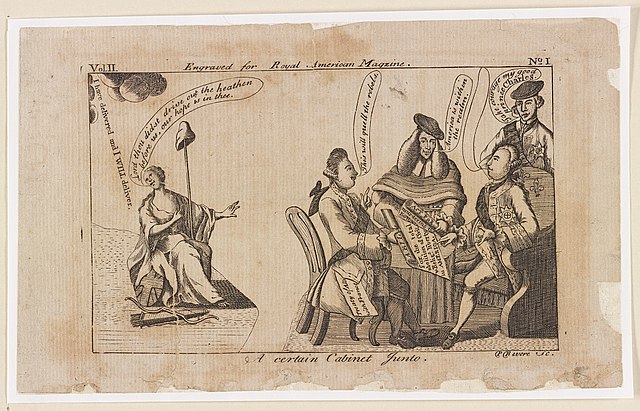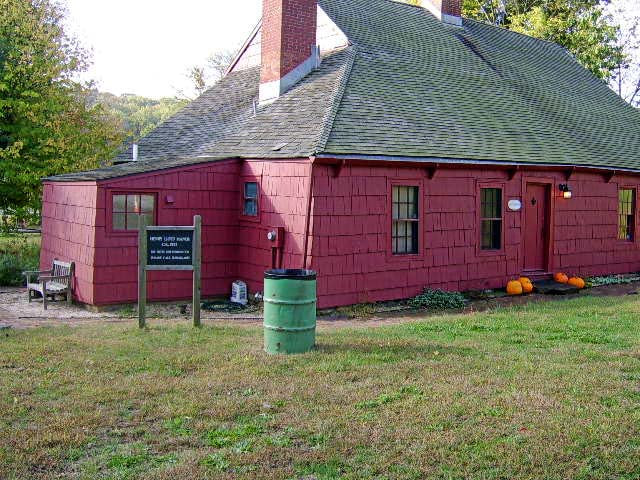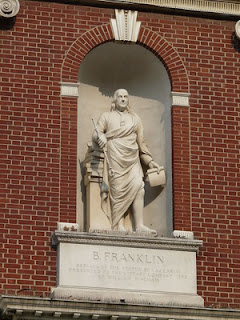Some of Oliver’s close friends and relatives, including his brother, Chief Justice Peter Oliver (shown here), and their in-law, Gov. Thomas Hutchinson, chose to stay away because they expected angry crowds.
Then a protocol mix-up caused the British army and navy officers to cut into the procession ahead of the Massachusetts legislators. Many of those politicians were already at odds with the Oliver–Hutchinson clan and grabbed the excuse to stay away completely.
Nonetheless, lots of people showed up—not to walk in the mournful procession but to watch it. “Such a Concourse or rather Multitude of Spectators I never saw at any Funeral here before,” the merchant John Rowe wrote.
The Cadets, the upper-class militia company that served as the governors’ honor guard, turned out for duty in the procession under their commander, John Hancock. That displeased some people, reportedly.
This is a story I see repeated in a lot of biographies without direct quotations or sourcing. The earliest version I’ve found appears in John Sanderson’s multi-volume Biography of the Signers to the Declaration of Independence, published in the 1820s and thus possibly based on people around in 1774:
The last instance, during the British administration, of the parade of this guard [the Cadets] was at the funeral of the lieutenant governor Oliver, under the chief government of general Gage [sic]; on which occasion Mr. Samuel Adams, hearing that Hancock designed, with the company, to perform the usual military honours to the deceased, who had been one of the most obnoxious tories of the whole continent, hastened to dissuade him from his purpose. But Hancock, in observing to his friend that the honours were designed for the office, and not the man, persisted in his resolution.Hancock and the Cadets marched with Oliver’s body to his grave at the Granary Burying Ground. Then the well-dressed militiamen fired three volleys over the grave.
The large crowd responded by shouting three cheers for the lieutenant governor’s death. Rowe reported: “There was after Colo. Hancock’s Company had fired & the Funerall over, as the Relations were Returning, Some Rude Behaviour.”
Hutchinson wrote:
Marks of disrespect were also shewn by the populace to the remains of a man, whose memory, if he had died before this violent spirit was raised, would have been revered by all orders and degrees of men in the province.Andrew Oliver had been politically unpopular for several years, having been hanged in effigy in 1765 as the Massachusetts stamp agent.
Peter Oliver later wrote:
The Vengeance of the Faction was carried to, & beyond the grave—Upon his Interment a large Mob attended, & huzzaed at the intombing the Body; & at Night there was an Exhibition at a publick Window, of a Coffin & several Insignia of Infamy—& at this Exhibition some Members of the general Assembly attended—could Infernals do worse?As I noted above, the chief justice stayed away from the funeral, and his memory was probably distorted by secondhand reports and the passage of time. The “Exhibition at a publick Window” that Peter Oliver mentioned was part of that year’s illumination in memory of the Boston Massacre. Ordinarily it would have gone up on the 5th of March, but that was right before the Sabbath, so the display was delayed until Money, 7 March, the evening before the funeral.
The descriptions of the 1774 illumination say nothing about pictures criticizing Andrew Oliver. Instead, one window targeted Thomas Hutchinson and Peter Oliver himself.
Some final details from John Rowe: “Then followed the Coaches & chariots amounting to Twenty, then the Chaises amounting to Ten.” And, “Minute Guns were fired from the So. Battery.”
















